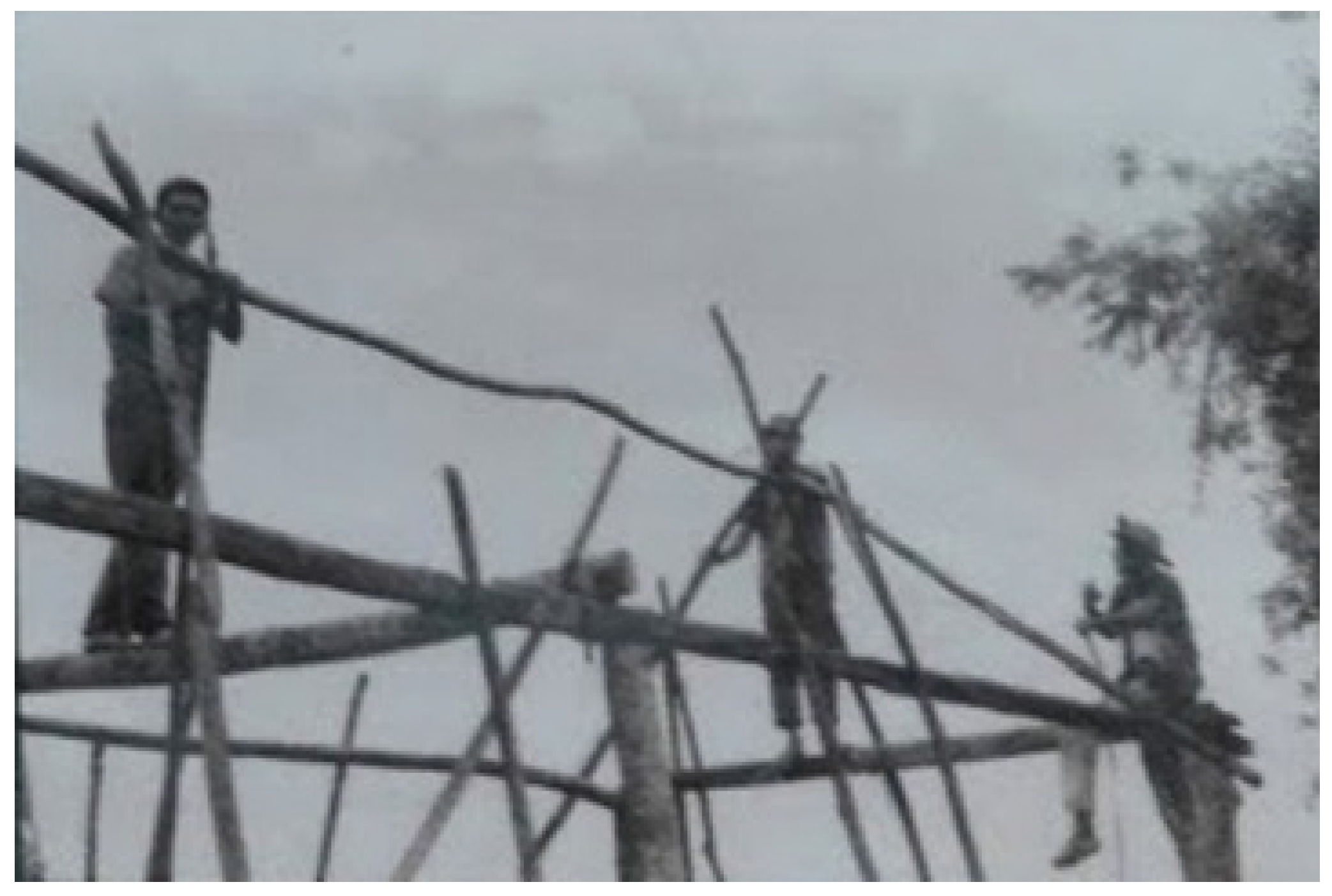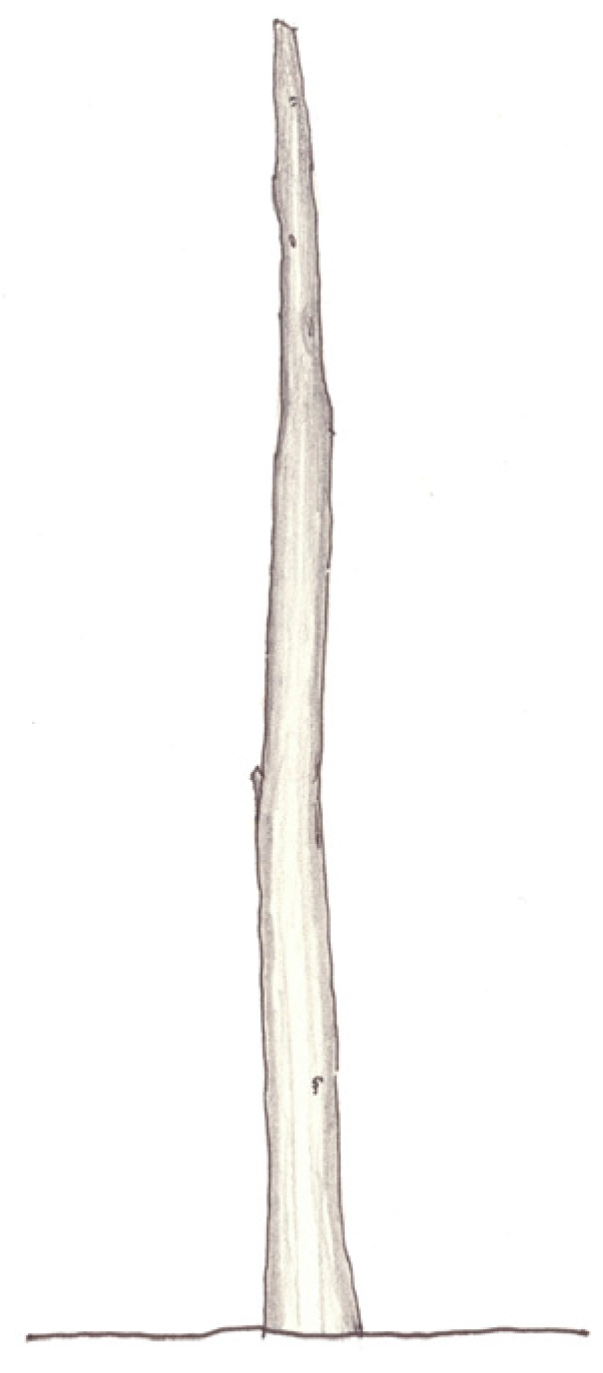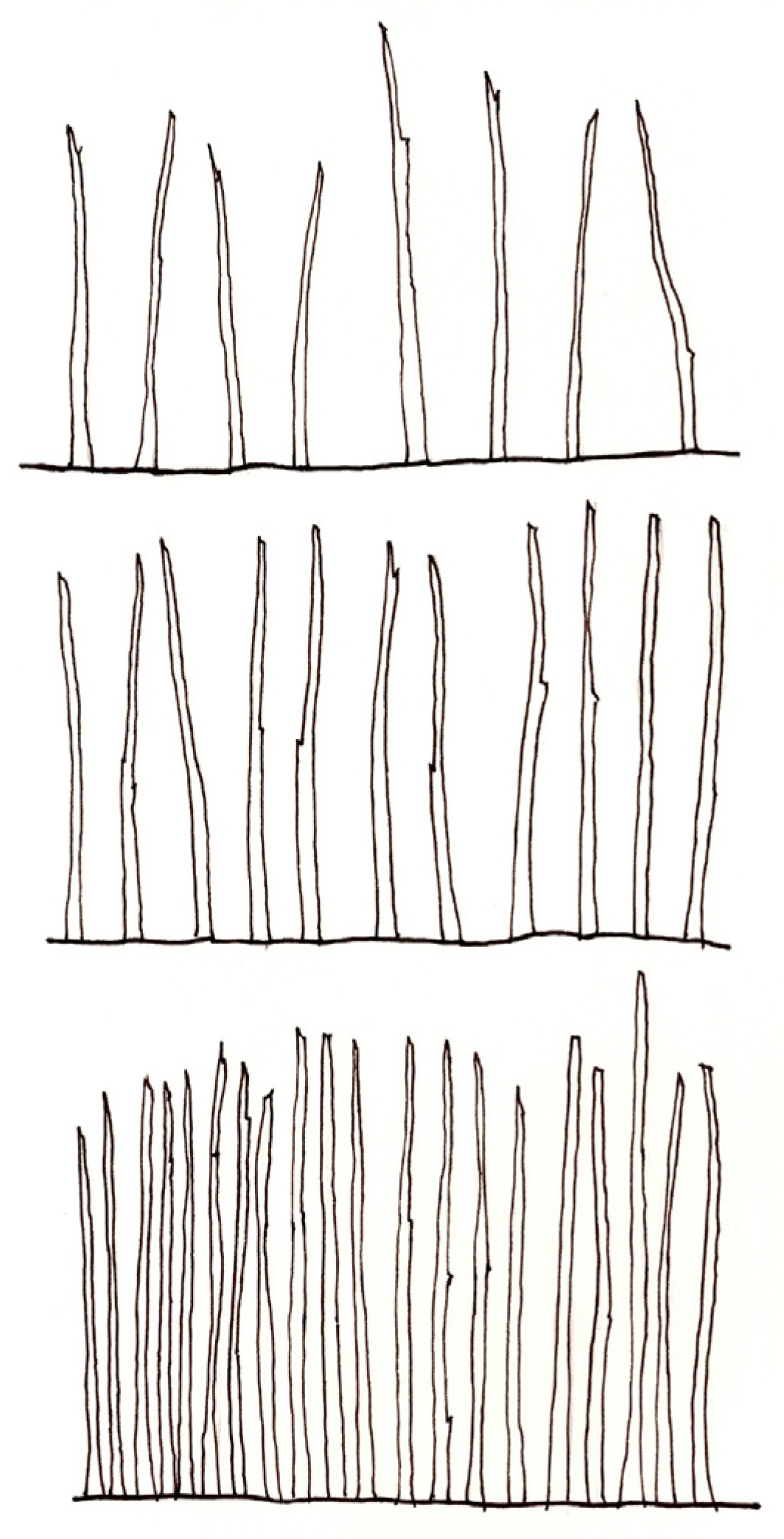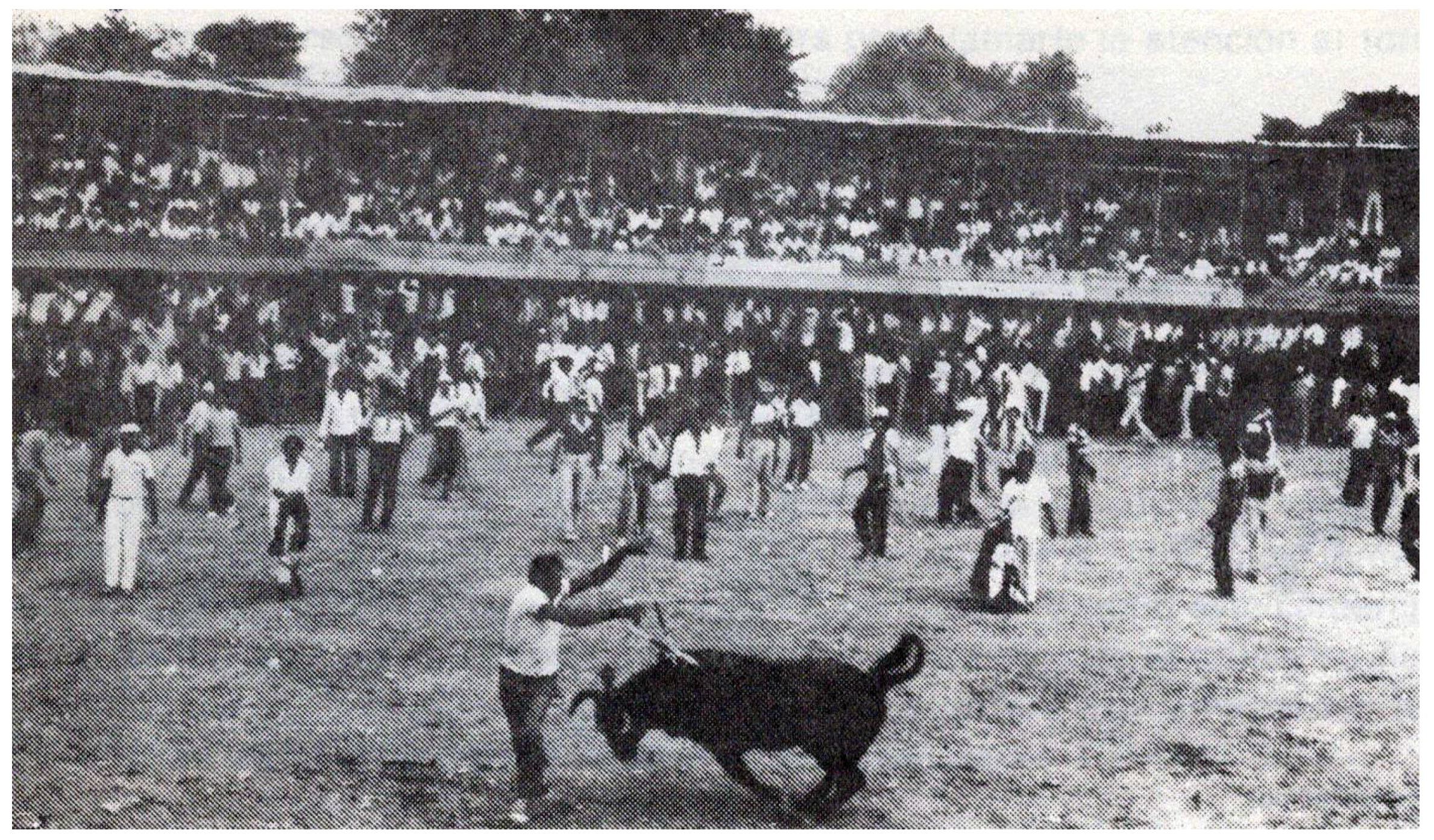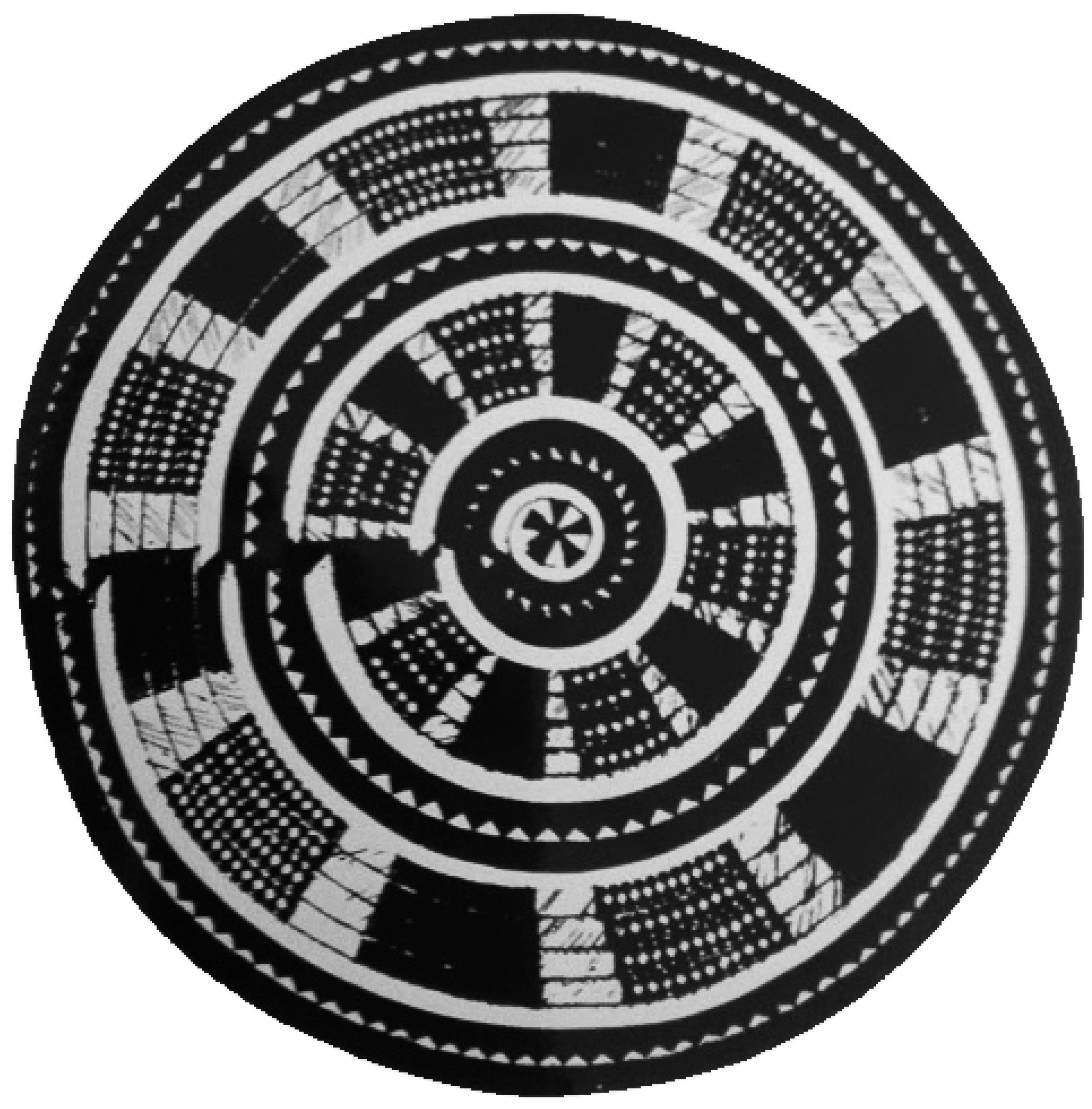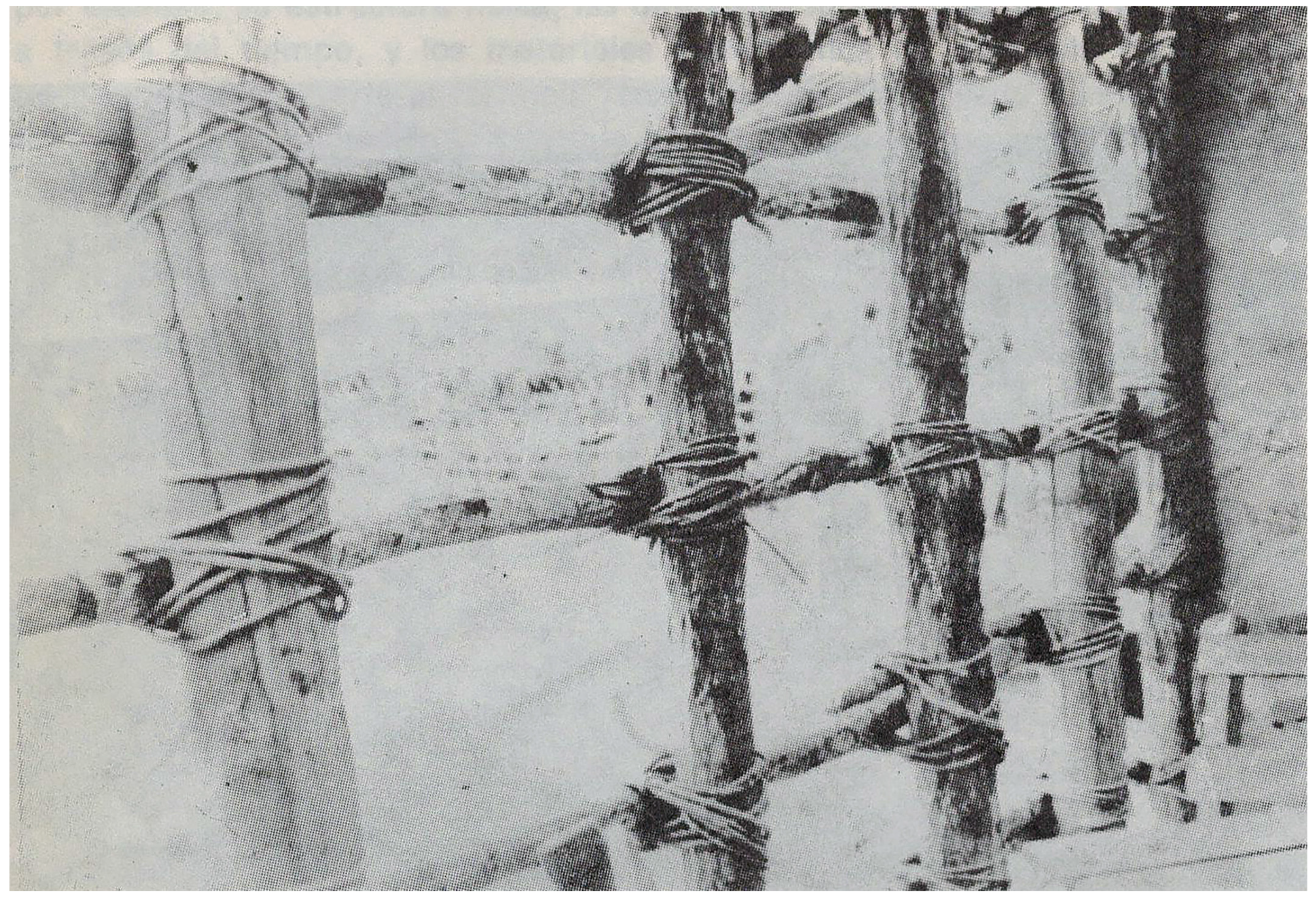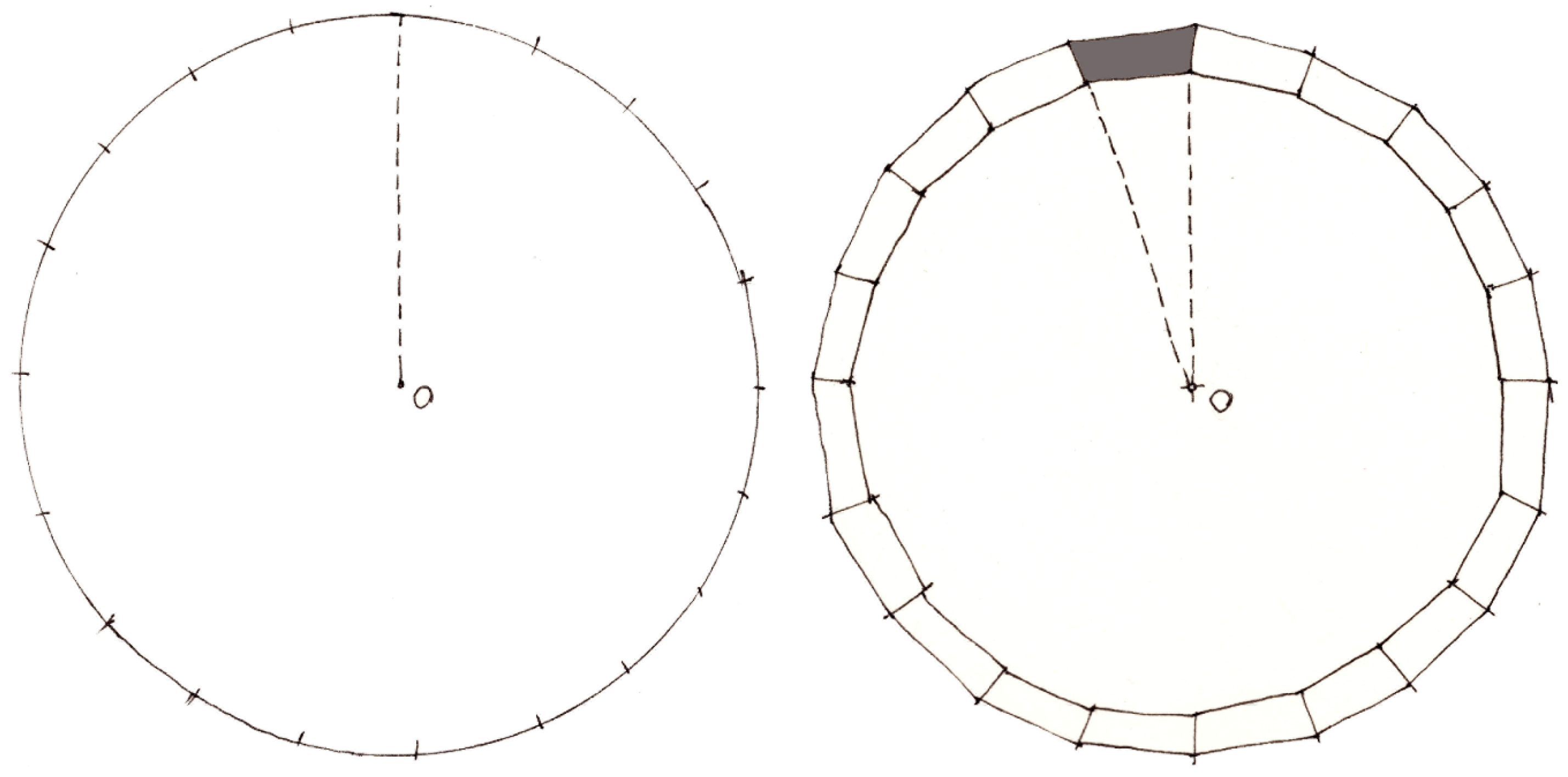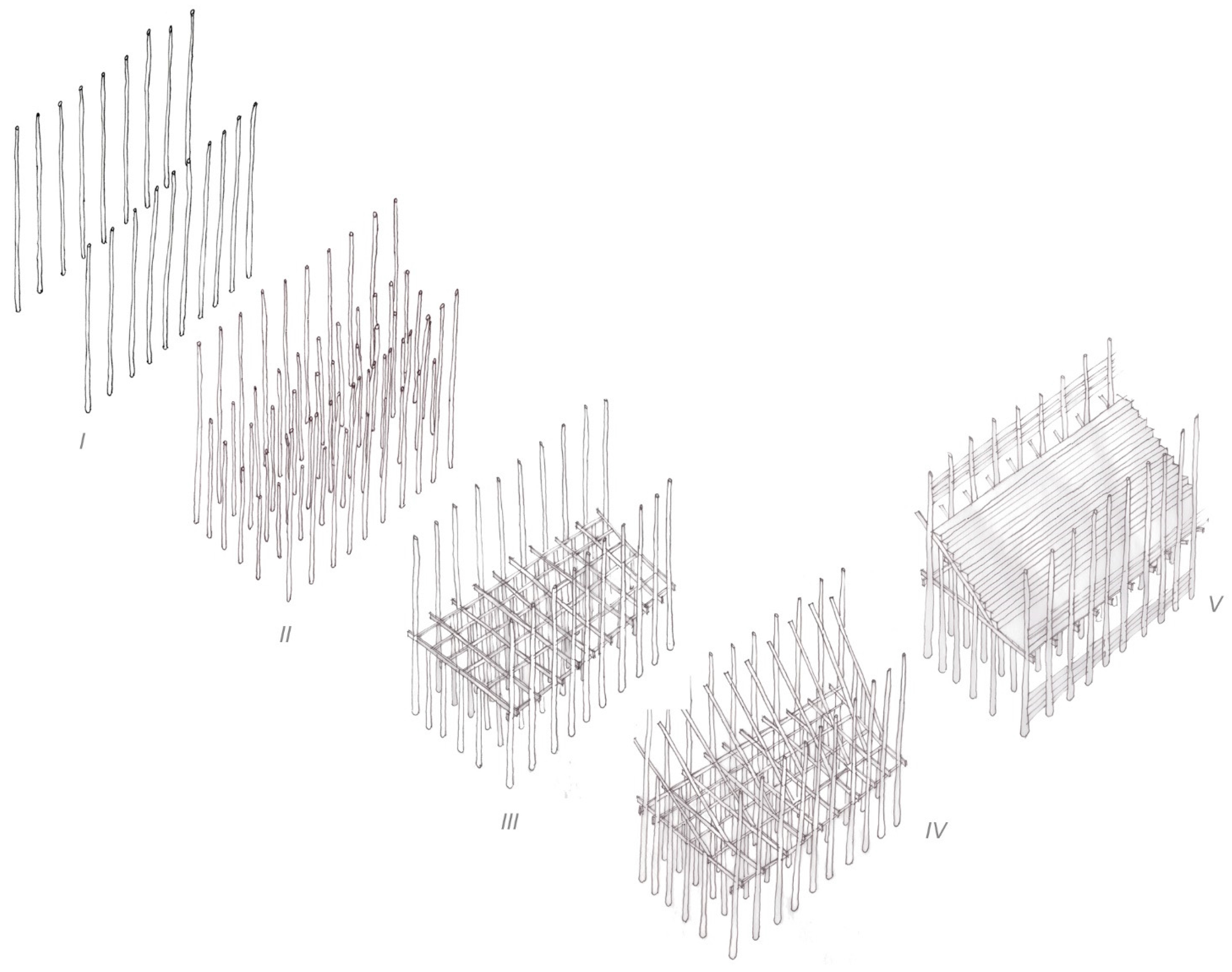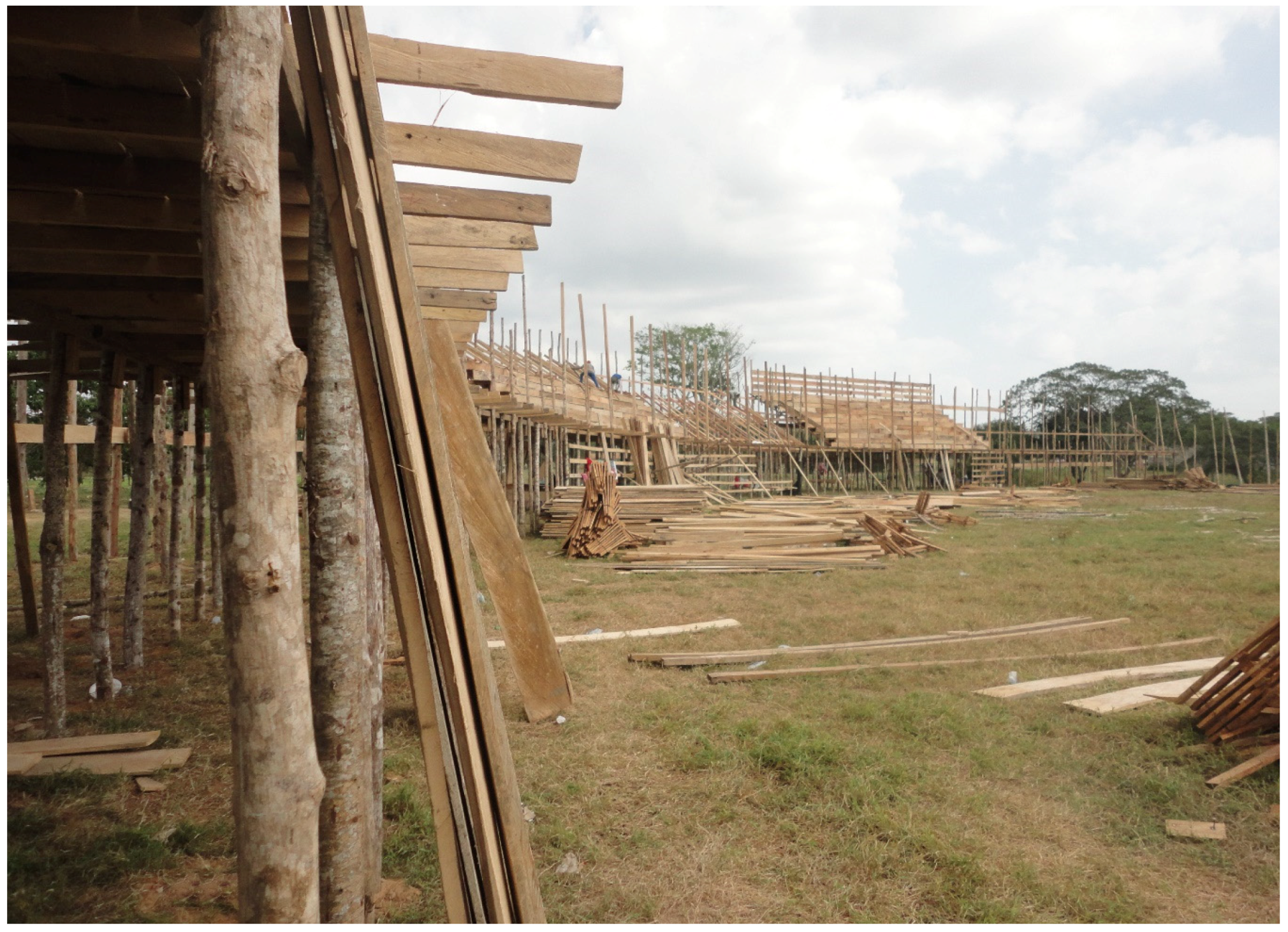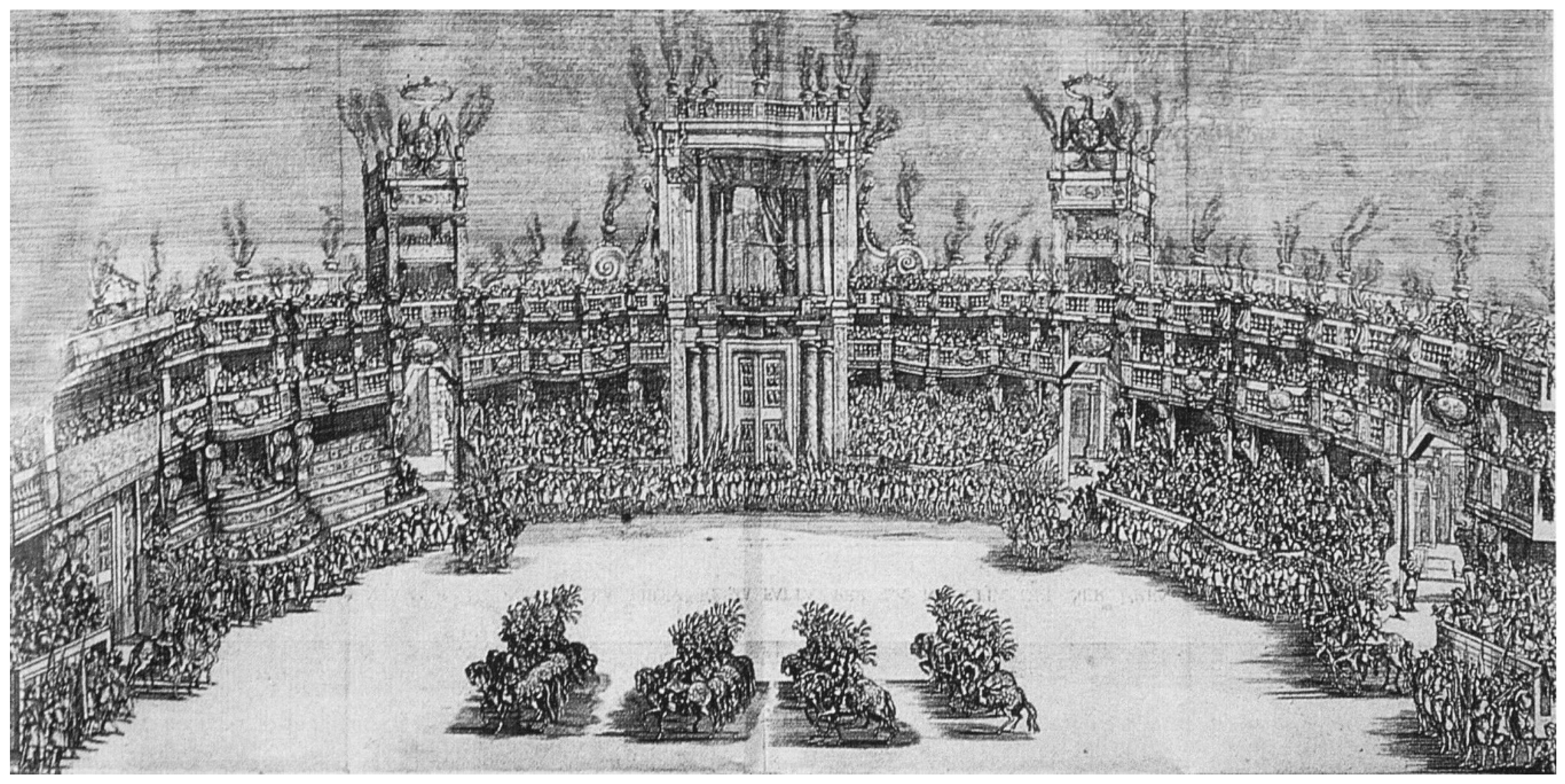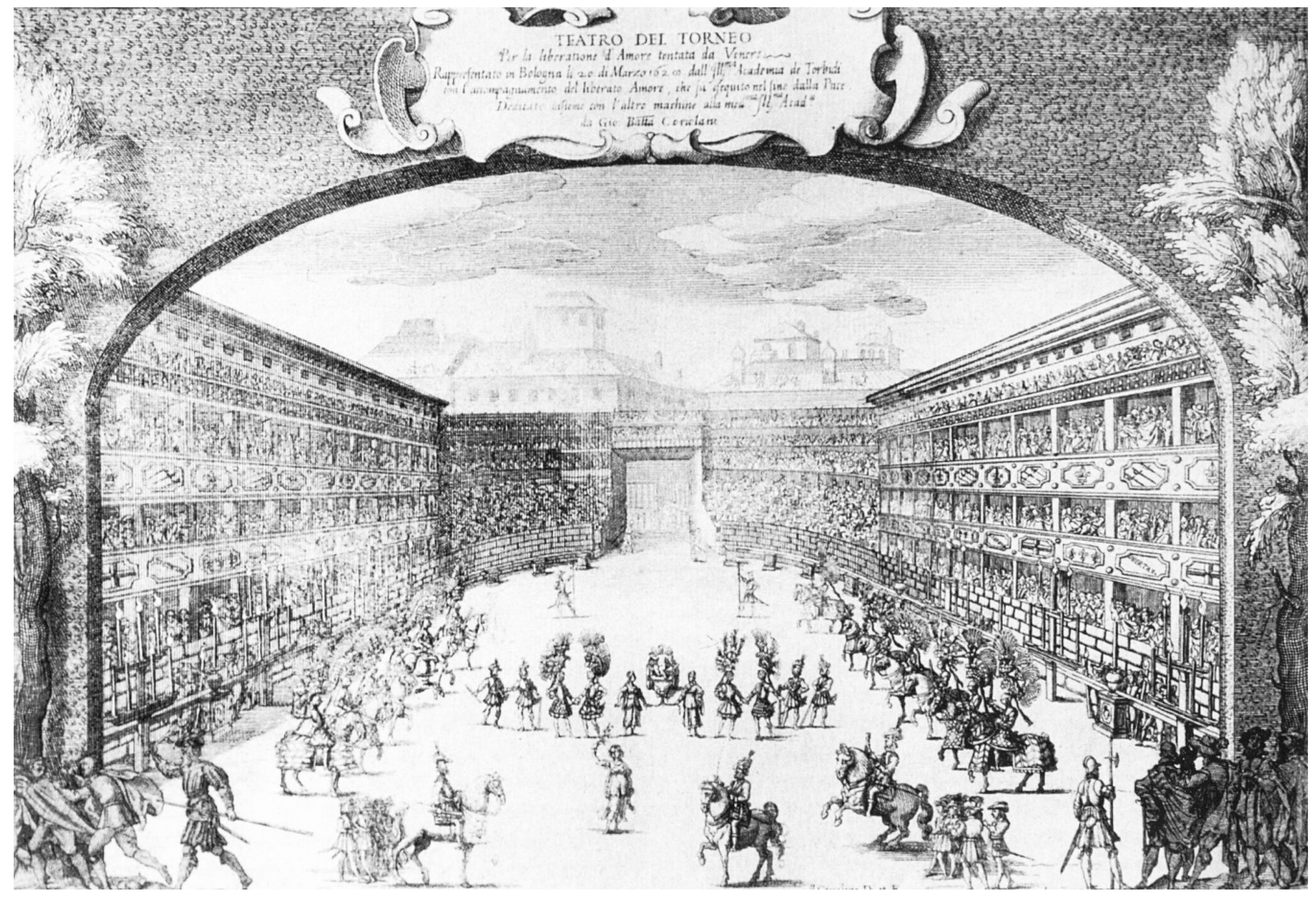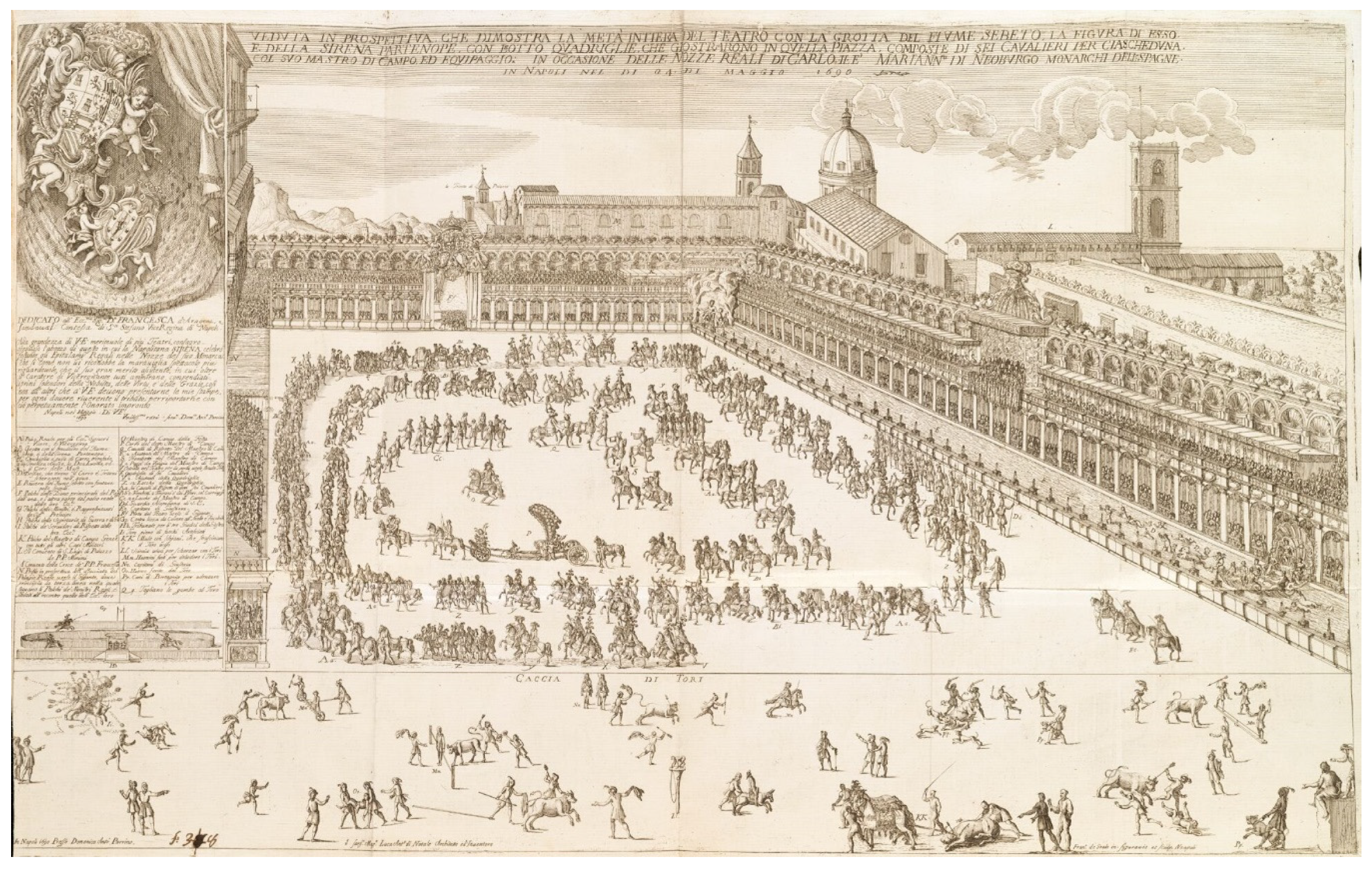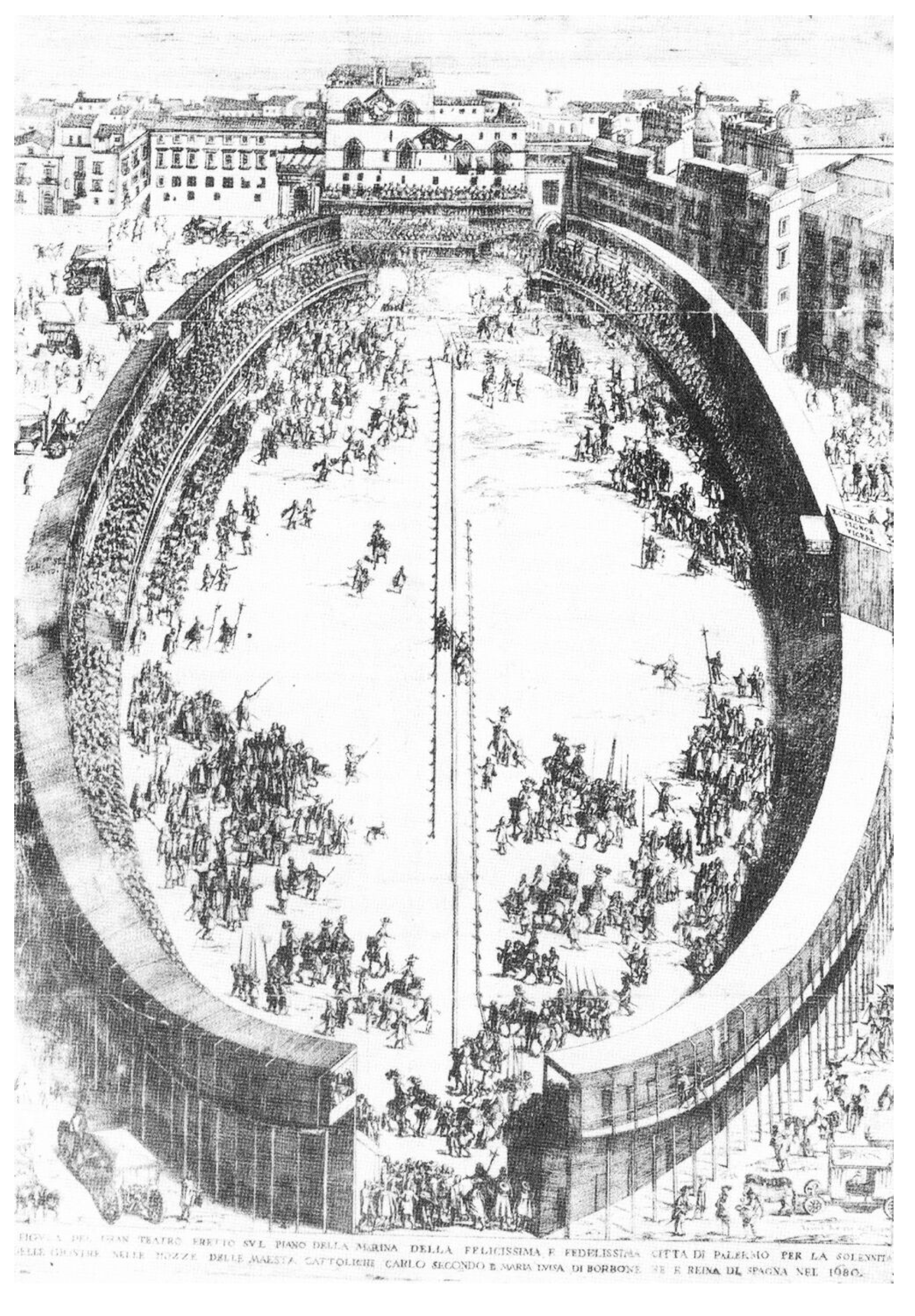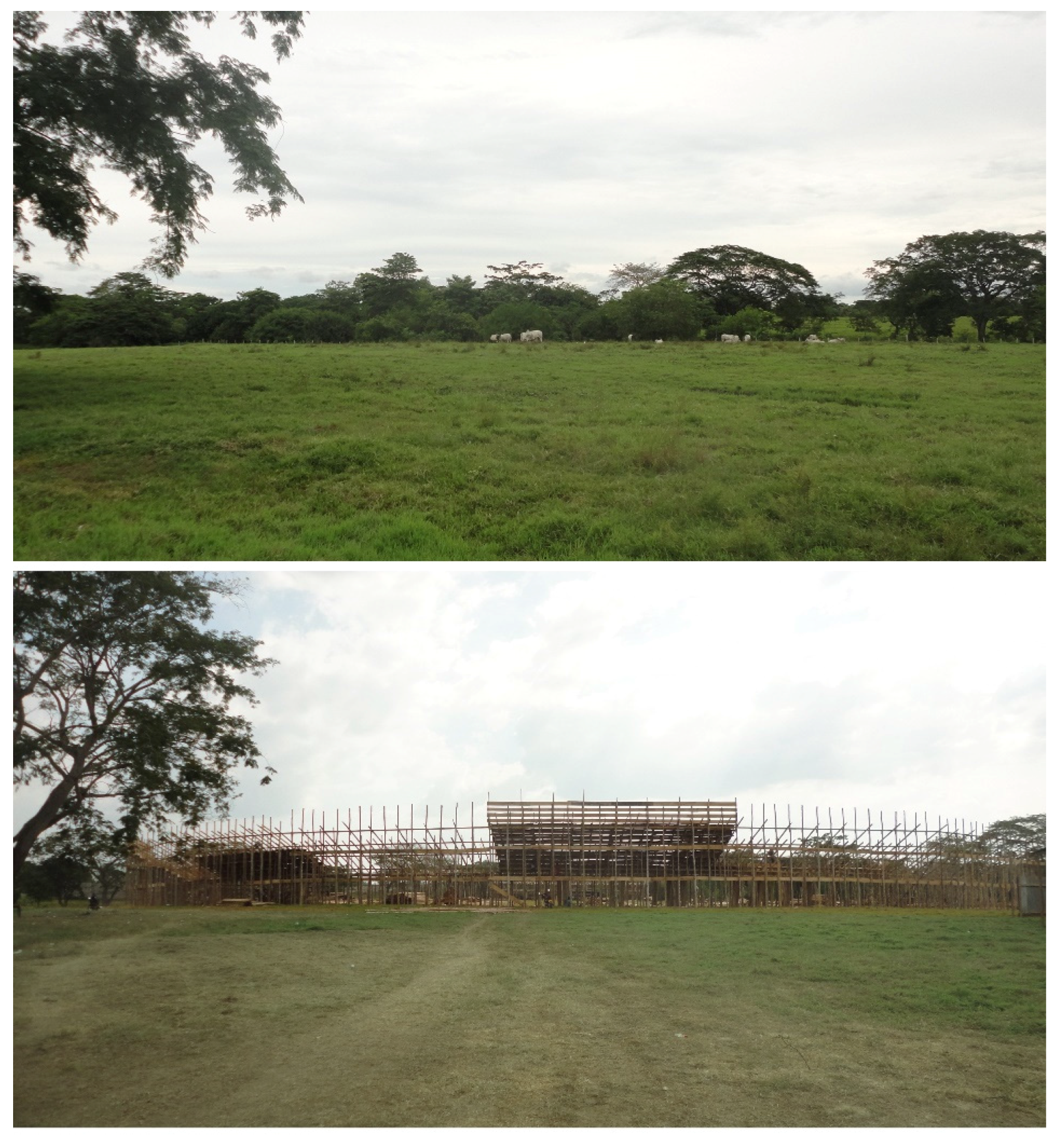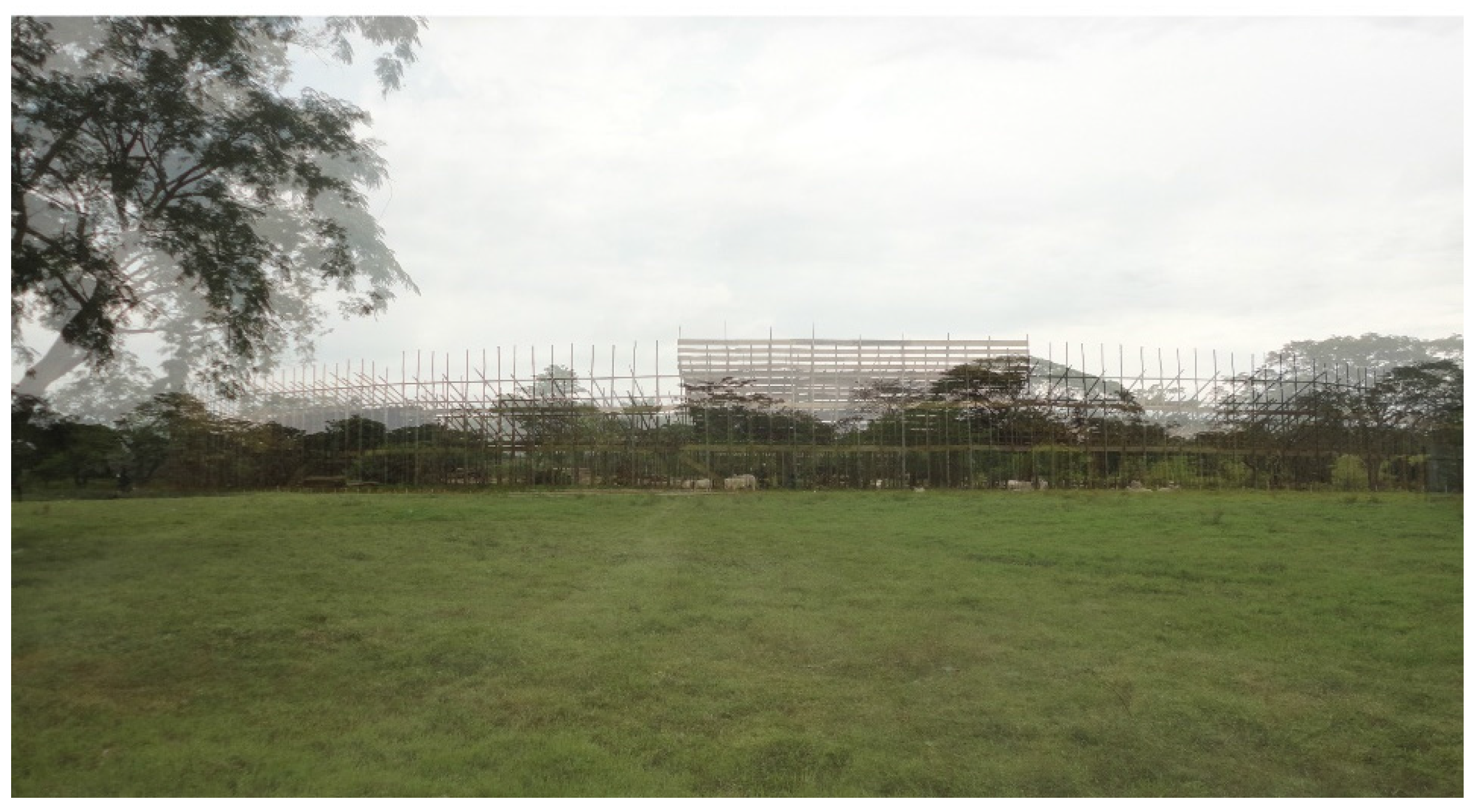1. Introduction
Along with increasing interest in preservation of stable heritage architecture, usefully destined for defining territory’s image and identity, important and amazing, but time-limited architectural forms survive. (In
Figure 1, traditional construction that still survives in the Colombian Caribbean). Therefore, they could be described as ephemeral [
1]. These architectures are often done cyclically, i.e., they are proposed in the same place, with the same aspects, every time. They are artifacts not only having an essential relationship with time but also with constructive aspects, that characterize their possibility of being built and demolished.
This architecture survives in the Caribbean region in Colombia, where constructive tradition is inherited from a knowledge related to concepts of assembly and disassembly that portrays the Caribbean vernacular architecture.
Throughout the region, particularly in Cordoba Department, landscape constantly shows humans’ extraordinary ability to rightly position natural elements which serve to create spatial relationships [
3]. (In
Figure 2,
barra de humo wood stick, a natural element used in Cordoba Department).
To a certain extent, man has been able to manage natural elements and do research on how nature works, understanding that there are possibilities to determine what is needed for life as well as to develop practical forms (techniques). ‘Control of vertical balance’ is confirmed in the landscape as the first activity and practical conquest enduring still today; and it is recognized through several types of barriers and horizontal lines formed by “living” ground-embedded branches, (In
Figure 3, sticks of alive branches in vertical position compose the landscape of Cordoba Department) seemingly representing origin and true form to re-order nature and meet a need [
5].
Wall birth seems to determine, regarding permeability degree, separation levels with the exterior, looking entirely like a sapient play enclosure [
6]. (In
Figure 4, fences of alive branches make up permeable enclosures) Wooden construction is always a light, serial, transparent and permeable work. An ensemble of finite or pseudo-finite elements (branches, trunks, etc.), wherein tectonics restates itself as the art of assembly, i.e., the connection not only of construction pieces, but also of nomadic objects.
Difference among enclosures is only a matter of infinite morphologic variables; however, for this study it is useful to point out the ideal formula of the circular enclosure that geometric intuition allows to achieve. The ancestral and overriding security requirement of human beings to create a protection against animals is evident. For example, an illustration of an armed man with a branch in his hand who, surrounding himself around 360 degrees, defends his integrity when feeling attacked. The man learns the circular movement and form by applying a circular shape when delimiting space through a physical barrier or fire circle to protect himself. But the circle is also the form of his group or family around the sacred fire. The last one, as Semper indicates, is considered one of the four patterns of the house which is pictured through the image of the Caribbean hut (in
Figure 5, structural trunks joined to live branches of the wall).
In fact, the circular enclosure later defined as “el corral” [
7], has validity because of its practical characteristics, such as external convexity that promotes a constructive resistance and sight economy. There are different views: the first one, from center to perimeter (to facilitate total control) and the second one, from any part of the perimeter to the center that is identified as the epicenter of the ‘mystical scene’. Bull festivals are a symbol of this, as Hemingway describes it, ‘the nature of dread and bravery’ [
8]. (In
Figure 6, a spontaneous brave person puts the
banderillas to the bull in a traditional Corraleja) Therefore, the enclosure is progressively conceived for new usages not only domestic, but also public, religious and festive; and the word “el Corral” provides the root for “Corralejas” which is known as the bullfighting festival within it. This study has been developed through several graphic representing forms, and bibliographic and iconographic analysis.
3. Discussion
The “Corralejas” as a cultural representation of the lands from the valleys and savannahs of the Sinu and San Jorge rivers in the Colombian Caribbean region, has a strong popular tradition from its beginnings at the end of the 19th century [
10]. Its vernacular architecture of popular tradition is perfectly comparable to Christopher Alexander’s definition [
11] of an ideal architecture, where characteristics such as timelessness and interaction between space and events must mainly be met. It is something that it is obtained with the precision and usage of the always present “language patterns” that are always there in what is called the “timeless way of building”. (In
Figure 7, the craftsmanship of the Vueltiao hat as a cultural and traditional representation of circular shapes in Cordoba Department)
The presence of “cultural patterns” in the construction of the Corraleja is the basis for making it an authentic and original architectural expression from the Colombian Caribbean region. Its center-polygonal constructive technique with vertical elements (wood slats) and horizontal pieces (madrines), spliced and assembled, is a practice that follows ancestral techniques related to weaving laws. (In
Figure 8, union of natural elements with
bejuco in a Corraleja) It is possible for these to be popular techniques connected to textile art, then transposed to the Corraleja assembly. This is a present quality in the four elements of Semper’s architecture [
12], i.e., building the Corraleja is possible for a Cordoba’s inhabitant because it is like making a handicraft work such as weaving a tapestry. Because he uses his constructive knowledge and developed techniques over time, they are also useful to set up other kinds of structures such as vertical looms in the field.
Nowadays, the Corraleja assembling process begins on an epicenter, with a fifty-meter average radial stroke and axes distributed every fifteen meters, where approximately twenty-two modules spread over a linear perimeter of three hundred meters are circumscribed. Each module has an installation of wood slats (material: vara de humo), making a reticular loom formed by five bays in one direction and nine bays in another direction. The bays are articulated by madrines. These are
caracolí, namely planks which form banisters and benches that profile a stand (semi-circle module formed by the union of all the modules); a very similar form to the bullring typology [
13]. (See
Figure 9)
However, the ideal form of the circumference cannot be achieved for reasons that are implicit in the limited time of assembly and disassembly, such as the lack of means to transform and domesticate the nature of the Cordoba landscape itself. (See
Figure 10) Consequently, it is necessary to review some cases in the architecture’s history, as well as the bullrings’ typology. (In
Figure 11, assembly of a Corraleja with the main constructive elements that make it up)
History suggests several examples where circular shapes persist in spectacle architecture, from the well-known Romans to the last bullrings’ experiences. Therefore, we trace a correlation between the circular shape of the “bullring” and Roman architecture. There are two amphitheaters located in France supporting these hypotheses: Nimes and Arles, reused for bullfighting shows in more recent times [
15].
The “Plaza de toros” circular shape is sometimes closely linked to the evolution of the bullfighting festival, which has developed into a show of struggle and combat, from its beginnings as an equestrian performance. In fact, the first events took place in public squares enabled for the occasion. First structures had a quadrangular shape that was better suited to the equestrian show. The plan “Plano de la plaza de San Francisco preparada con la tribuna para la plaza de toros” in Seville (anonymous watercolor of 1730 kept in the municipal archive) shows, in the quadrangular public space, a wooden scenery with tiers and stages defining the festival enclosure through the integration or super-position with the square’s architecture [
16] (See
Figure 12). The anonymous outlook of the watercolor of 1730, preserved in the municipal archives of Seville, is a rare image of the ephemeral staging of the bull’s feast, because it is still quadrangular.
Only in the second half of the 18th century was there a progressive transition towards circular solutions, which were better suited to the evolution of the “corridas” spectacle thanks to the renewed interest in neoclassical culture boosted by findings of the Roman era [
17]. These models, quadrangular squares before, and circular shapes later, were also extended into the Spanish colonies such as in Mexico [
18], and generally in South American countries such as Colombia, where Corraleja, the subject of this study, represents a direct expression [
19].
First installations in European and Latin American public squares were mobile. They were essentially constituted by a quadrangular enclosure structured with stages and tiers to welcome the public. Then, they became permanent architectural forms over time. Rectangular buildings, especially those from the initial stage, were made of wooden structures in public places, such as the Corraleja of today. They allow for some analogies in the festival’s ephemeral architecture, perhaps more consistent than those which were sought with the circular architectures for spectacles in the Roman era.
In fact, there is a rich tradition of equestrian events and knightly tournaments organized during civil or religious celebrations. The festival iconography, which gives us a representation of the ephemeral event by bringing it to us, shows some scenographies with the theme of the enclosure that house the most chivalrous and playful events and many spectators in the stages and steps. In Europe, streets and squares of cities are the places generally used for festivals, where the enclosure is the space for entertainment. It is an open-air theater of demonstrations with an equestrian tournament nature in its majority, but also with characters of mythological and/or historical reconstructions, often under the form of parody.
The drawing of G.B. Teatro Coriolano of the Tournament for the Liberation tentata de Venere, done in Bologna (Italy), on 20 March 1628, shows a rectangular perimeter with semicircles on the short sides. It is structured on three levels at length and has a stage in the hemicycle in the background. In the center, the scene is occupied by an equestrian event with some knights and horses. (See
Figure 13)
The vision of the theater tournament “The triumph of virtue”, held in Modena (Italy) in 1660 shows part of a group of planks prepared for a party with weapons on horses, drawn by Girolamo Graziani. The enclosure seems to have a structured circular shape with stages in the lower part and two levels of sceneries in the upper one. (See
Figure 14)
The engraving made by F. De Grado; for the preparation of the party for the tournament in the Royal Palace Square, held on 4 May 1690 by Luca Antonio di Natale, a military Italian engineer and architect, on the wedding of King Carlos II and the princess Ana Maria de Neoburgus, shows a rectangular enclosure that incorporates galleries and stairs in multiple levels. In the scene center, there are equestrian games where the most interesting element, because of its relationship with bullring, is the presence of bullfighting, which is expressly indicated in the lower part of the same perspective “caza de toros”. (See
Figure 15)
The engraving by P. Maggio for the tournament in the Piazza Marina in Palermo (Italy), on the marriage of Carlos II and Maria Luisa de Borbon in 1680, presents an elliptical fence built on models of the Roman amphitheaters with stages and sceneries. (See
Figure 16)
Fences with a variety of solutions are those made on the
Festa della Porchetta in Bologna, which is repeated more than 140 times between 1597 and 1796. A study about the Bologna Festival reveals how a designed component for the enclosure is a rectangular planimetric system that alternates oval or semicircular mix-lineal solutions in a few cases, but in most cases, a solution of open fences [
24] is presented.
4. Conclusions
Considering the festival models offered by the Baroque culture, it is good to enquire what role Roman constructions have played in the circus-theater; rediscovered so far in time with the advent of neoclassical culture; and up to what extent the experience of the party and the ephemeral enclosures for the spectacle have influenced structuring and definition of the Plaza de Toros in Spain and, thus, Colombian Corralejas.
Based on the reflections made, it can be assumed that Corralejas still preserve the ephemeral nature of these architectures for bullfighting in 18th century Spain, when they started to stabilize. The circular shape definition must be sought only partially in the Roman architecture for the spectacle; which certainly influences the experience in the transition from the ephemeral to the stable. While enclosures may have played a significant role for festivities, the Baroque ones had an ephemeral and playful character.
Festival’s enclosures—Corralejas—are almost always made for religious celebration too. The Corraleja is a place for spectacle and events, as well as demonstrations of cavalry, celebration and parody. This finds majestic moments with the courtly Baroque in Europe where they acquire, in some cases, a stable character, while a more linked character to the simple local tradition is retained in the Caribbean, becoming extraordinary declensions of a vernacular constructive tradition.
One more substantial difference surely exists among several experiences of bullrings and Corralejas. The first one is developed as an urban place (a true stable square). In the second case, the idea of an ephemeral and nomadic architecture, always well connected with the constructive vernacular tradition, endures. It also coincides, not accidentally, with an outside place in the middle of the countryside, (In
Figure 17, Cordovan landscape is a mixture of cattle and nature: before, while and after the ephemeral installation of Corraleja) i.e., a true enclosure of tree’s trunks which are domesticated in the Cordoba landscape.
The Corraleja represents a unique architectural example of its genre due to its provided characteristics. For this reason, it is necessary to continue doing scientific research on its relevance and scope; simultaneously and forwardly preserving it through a formal declaration of architectural heritage.
